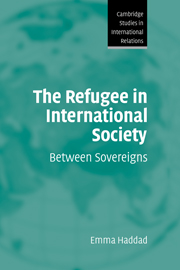Book contents
- Frontmatter
- Contents
- Preface
- 1 The refugee ‘problem’
- PART I The refugee: a conceptual analysis
- PART II The refugee: an historical analysis
- 5 The inter-war perspective
- 6 Refugees and international protection in the Cold War era
- PART III The refugee: a contemporary analysis
- Select Bibliography
- Index
- CAMBRIDGE STUDIES IN INTERNATIONAL RELATIONS
6 - Refugees and international protection in the Cold War era
Published online by Cambridge University Press: 22 September 2009
- Frontmatter
- Contents
- Preface
- 1 The refugee ‘problem’
- PART I The refugee: a conceptual analysis
- PART II The refugee: an historical analysis
- 5 The inter-war perspective
- 6 Refugees and international protection in the Cold War era
- PART III The refugee: a contemporary analysis
- Select Bibliography
- Index
- CAMBRIDGE STUDIES IN INTERNATIONAL RELATIONS
Summary
The attitude of the totalitarian states towards the would-be exiles is necessarily ambivalent. They would like to get rid of them – but they are also reluctant to let them go.
Paul TaboriThe refugee issue cannot be divorced from the political context in which it operates at any one time, and international responses to the ‘refugee problem’ soon became entangled in the Cold War environment. But the changing refugee regime was also indicative of the international system as it developed in the post-war years, affected by a shift to fixed borders, negative sovereignty and individual human rights. The post-war years indicated a reorganisation of the map and a shift in state–citizen relations, but this did not remove the ‘problem’ of the refugee.
This chapter first asks how the Cold War period represented a continuation from the decades of international refugee regimentation preceding it, before examining the fundamental changes and differences. It then considers the Berlin Wall as representative of impermeable borders that were erected in this period as a barrier to refugee creation. Fourth, it discusses non-European displacements of persons as inherently contradictory to the Cold War (western) understanding of ‘refugees’. Finally, it analyses what the Cold War normative responses towards refugees meant in terms both of refugee identities and the identity of international society itself.
Continuities in the refugee regime
If the creation of refugees leading up to the First World War and during the inter-war years saw the start of the ‘modern’ extent of the refugee problem, the mass of refugees created by the Second World War was on an even greater scale.
- Type
- Chapter
- Information
- The Refugee in International SocietyBetween Sovereigns, pp. 128 - 162Publisher: Cambridge University PressPrint publication year: 2008

